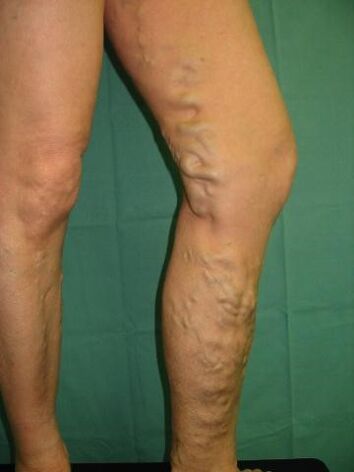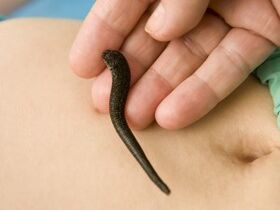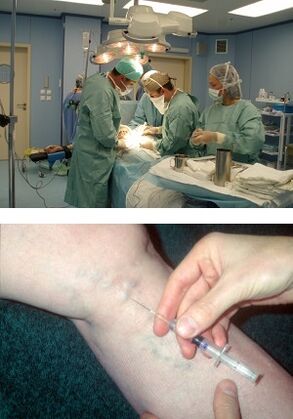Varicose veins or in normal people, varicose veins are irreversible and continuous elongation and expansion of veins, especially of the lower legs, as well as the formation of certain "knots" due to venous wall pathology or due to genetic defects (lack of valves).
Today, varicose veins are a very common disease. It affects every tenth man and every third woman. The more a person leads a sedentary and inactive lifestyle, the more he or she is prone to this disease.
The United States, France, UK - are the main countries in the spread of varicose veins (on average more than 30% of the population).
Causes of varicose veins
This use appears with an increase in venous pressure. It is generally accepted that varicose veins are exclusively from the lower extremities, however, there are varicose veins from the esophagus, stomach, testicular veins or varicose veins in the small pelvis.
By the way, the latter is one of the reasons for fairly common diseases such as hemorrhoids.
The main causes of the development of varicose veins include:
- Gender: Often in female representatives, varicose veins are provoked by the intake of various hormone medications or pregnancy.
- Descendants
- Increased venous pressure, including due to weight problems, inactive sedentary lifestyle.
The above reasons contribute to the expansion of veins and disruption of the normal function of venous valves.
The stage of the disease
The following levels of varicose veins are distinguished:
- The beginning- it is characterized by pain in the legs, swelling and heaviness. Disease prevention at this stage, however, is more appropriate.
- First stage- jugular veins, spider veins, which can be seen through the skin, are also added to the above symptoms. Burning sensations in the feet and calves often occur.
- The second level- the number of varicose veins and asterisks increases sharply, becoming more pronounced. The pain became unbearable, the feet felt dry.
- The third stage- here the skin of the feet is directly affected. It becomes cracked, lifeless and dry. In addition, it is possible to change the pigmentation and structure of the skin on the feet. The venous nodes begin to take on a convex shape.
What happens to varicose veins?

One of the first symptoms of varicose veins is swelling of the legs, deformities and heaviness in the calves that are frequent when sitting for long periods of time.
No less also characteristic of varicose veins is the reduction or disappearance of these symptoms after resting or night walking.
If you do not start treatment on time, the following symptoms appear - pain in the broken calf, cramps in the calf muscles, a feeling of heat in the legs.
Also on the legs you can see the red-blue vascular "stars", the saphenous veins expand and you can see the intradermal dark blue veins.
With advanced varicose veins, thrombophlebitis (inflammation of a dilated vein with the formation of blood clots in it), eczema in the affected area or trophic ulcers can develop.
To eliminate the risk of manifestations of varicose veins, it is necessary to get rid of the main causes of their occurrence and external factors: smoking, alcohol, unhealthy diet.
Varicose veins on the lower legs develop due to lack of fiber -rich foods in the diet. It is an intestinal cleanser that removes waste products, pus, toxins and radionuclides from the body.
The shape of varicose veins
There are types (shapes) of lower extremity varicose veins:
- Localized venous lesions with defective discharge through communicative or pathological veins.
- Intradermal or subcutaneous duct lesions localized without reflux.
- Extensive venous involvement with defective deep venous blood flow.
- Extensive venous lesions with impaired blood flow through the communicative veins.
In addition, isolated separately, the reticular -like shape of the varicose veins. This is a common type of varicose vein, thus there is a thin intracutaneous vein development
Diagnostics

While observing the initial symptoms, you should immediately contact a specialist who deals with venous diseases - a phlebologist.
Success in treating leg varicose veins is highly dependent on when you start treatment. Naturally, the earlier you see a doctor, the lower the risk of complications.
After the first examination, the doctor will order an instrumental examination, usually a Doppler ultrasound.
It happens that radiopaque and radionuclide methods are used, if the need arises.
With this method, a special substance is injected into the bloodstream, and then its distribution through the blood vessels is studied.
How to treat varicose veins
Varicose veins can be treated with 3 methods:
- Sclerotherapy.
- Performing surgery on varicose veins.
- Medication (conservative treatment).
In addition to the above methods, the complex uses medical knitwear and physiotherapy training.
Below we will consider in more detail each of the 3 methods.
Sclerotherapy

Scleteropia is a painless, non -surgical, and most importantly high quality and effective method of treating varicose veins. This is a method of treating varicose veins that is relatively young compared to the others.
One of the main advantages of sclerotherapy is that the treatment does not require hospitalization, i. e. the treatment is done on an outpatient basis, and does not affect the rhythm of the patient’s life.
The essence of this method lies in the fact that a special sclerosing drug is carefully injected into the "diseased" vein, which causes a kind of "adhesive" of the vein.
After the end of the procedure, a bandage is applied, which must be worn for a week. During this time, the veins become too large, after which they disappear and blood flow is restored.
Unfortunately, not all types of varicose veins can be treated with this method. If the patient needs surgery, then sclerotherapy will not only not help in this case, but can also cause a number of complications, and possibly even deterioration.
For example, there is a classification of varicose veins by eye, in which varicose veins are divided into degrees, and this method can only treat stage 1 varicose veins.
As for the consequences caused by sclerotherapy, it is the preservation of small bruises for a short time and a bit of pigmentation on the "diseased" veins.
Performed by professional doctors, this method guarantees lasting results: the veins widen "close" and blood flow never returns through them.
Operation
Surgical treatment for varicose veins or laser surgery for varicose veins. Currently, this method is one of the main methods. One, there are a number of contraindications:
- During pregnancy or a woman who has just given birth, it is recommended to wait at least 5 weeks, because in many cases, varicose veins that arise during pregnancy disappear on their own without intervention.
- If you are concerned with aesthetic problems exclusively and there are no other symptoms (varicose veins, pain).
- Surgical methods to treat varicose veins are indicated only if others do not make sense or will not bring results.
Treatment of varicose veins with surgical methods is carried out, as a rule, on an outpatient basis, without hospitalization of the patient.
There are 3 methods of surgical treatment of varicose veins - ligation, stripping and microphlebectomy.
- League- This is a kind of varicose vein ligation. As a rule, this method is used in combination with others, for example, it serves as an adjunct to stripping or phlebectomy.
- Stripping- a surgical method for the treatment of varicose veins, in which the "diseased" vein is removed using a small thin probe.
- Microflectectomy- The essence lies in the removal of varicose veins through punctures, which are made in the skin.
Methods of drug treatment
Drug therapy is an equally important component in the treatment of varicose veins. Competently selected medication will help not only to eliminate the basic manifestations of varicose veins, but also to reduce the risk of complications.
A large number of these medications help relieve swelling and pain syndromes, improve blood flow, and so on.
This medicine helps in the following:
- Improves lymphatic drainage function.
- Improves general venous tone.
- Improving the microcirculation of hemorheological disorders.
It should be borne in mind that the use of these drugs, like others, should be carried out exclusively after a thorough examination and as determined by a doctor.
Treatment with folk remedies for varicose veins
In addition to traditional medicine, there are also recipes from "folk" first aid kits:
- Take a few cloves of garlic and finely chop. Note that only garlic with white husk is used! Then stir with two tablespoons of butter. We use the gruel produced on the "sore" veins for the night, on parchment paper, secure with a tight bandage and finally wrap it with a warm scarf. In the morning, after a shower, we dressed warmly.
- Hop infusion is an equally effective folk remedy against varicose veins. Take a hop cone (make sure it is dry) and pour 1 glass of boiling water. Leave for an hour and do not hesitate to take the infusion half an hour before eating in a glass.
And remember that varicose veins are not a single sentence, they are still possible and should be treated, and the sooner you turn to a specialist, the easier and more effective the treatment will be.
Be healthy!




































